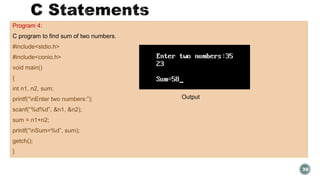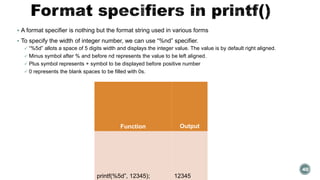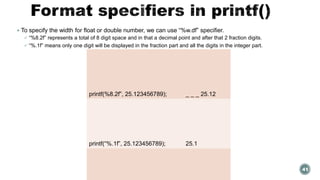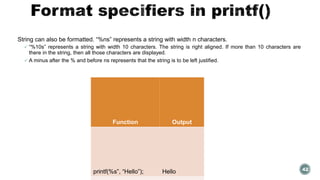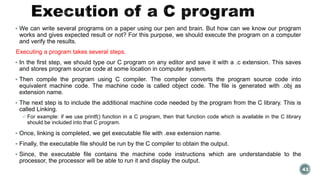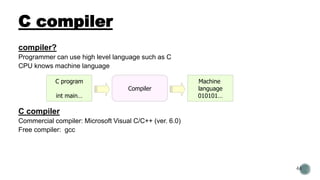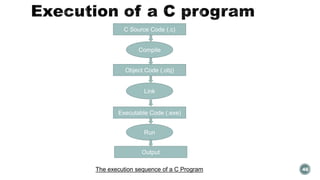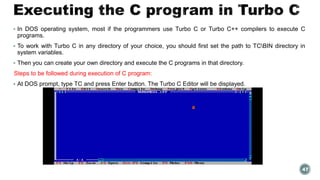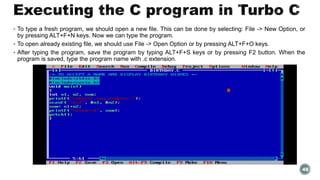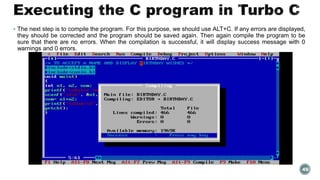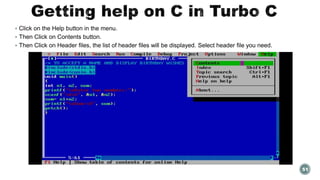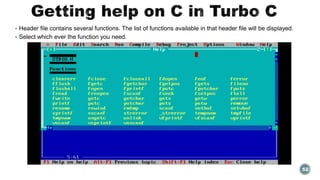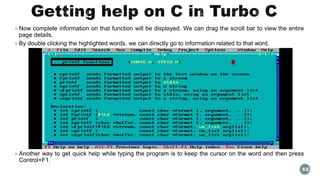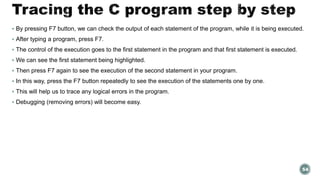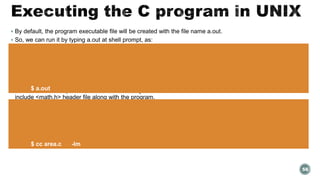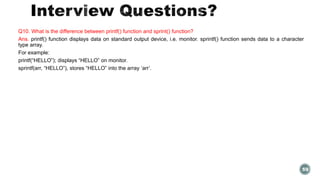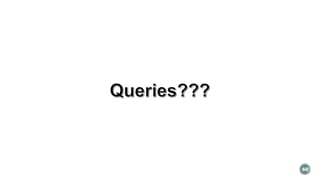This document discusses the C programming language. Some key points:
- C was developed in the early 1970s and influenced by many other languages. It is a middle-level language that provides high-level and low-level capabilities.
- C is widely used to develop operating systems, device drivers, databases and other core systems software. It remains popular due to its portability, efficiency and ability to interface with hardware.
- The document outlines C's basic syntax including data types, variables, constants, functions and control structures. It provides examples of common functions like printf, scanf and input/output statements.
- Overall the document serves as an introduction to the C language, its history, capabilities
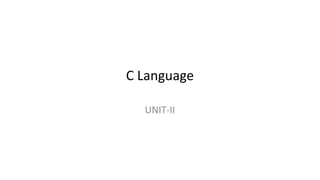
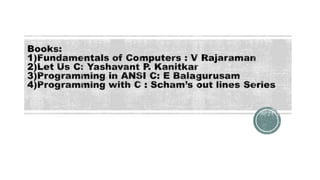
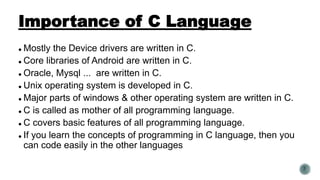
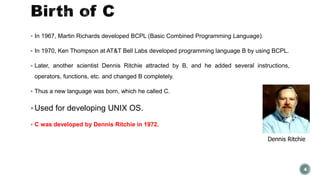
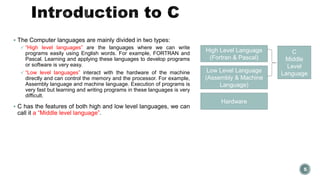
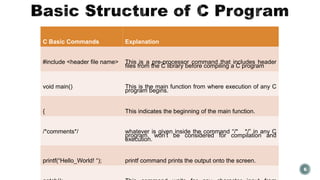
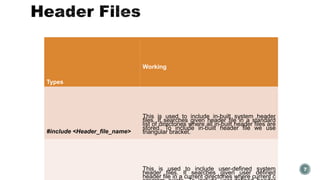
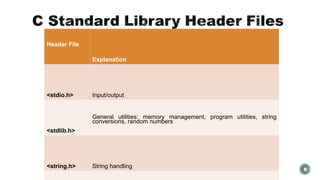
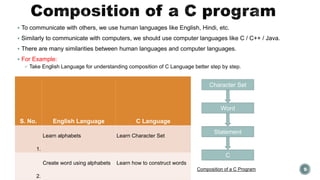
![ We should use only the following characters in writing a C program.
These characters can be combined to create C words.
10
Set Type Characters
Alphabets A, B, C, D,…….,Z, a, b, c, d,…….,z
Numeric digits 0, 1, 2, 3, 4, 5, 6, 7, 8, 9
Special Characters + - * / % ? & | ! = [ ] ( ) { } < > ‘ “ @ # ^ . _ , : ; ~](https://image.slidesharecdn.com/lect-230919084947-cab2cdf5/85/Lect-2-3-Introduction-to-C-ppt-10-320.jpg)
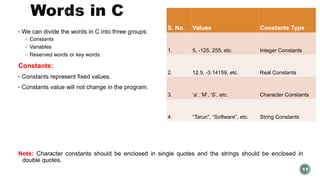
![Variables:
Variables represent words which store varying (Changing) values.
For example:
Here, x is the name of a variable whose type is ‘int’. It store an integer number in variable x.
If we store an integer number in a variable, then it is called Integer type variable.
If we store a real number in a variable, then it is called Float type variable.
If we store a single character in a variable, then it is called Character type variable.
In the above example, empcode, emp_sal, and sex are the names of the variables.
12
int x;
//Data type declaration statements
int empcode;
float emp_sal;
char ch, sex, name[30];](https://image.slidesharecdn.com/lect-230919084947-cab2cdf5/85/Lect-2-3-Introduction-to-C-ppt-12-320.jpg)
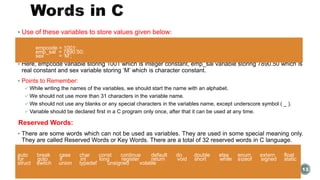
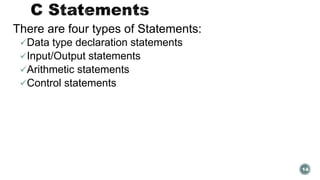
![Data type declaration statements
Data type declaration statements describe the data that the program is going to use.
Declaration statements come before any executable statements in c program.
15
//Data type declaration statements
int empcode;
float emp_sal;
char ch, sex, name[30];](https://image.slidesharecdn.com/lect-230919084947-cab2cdf5/85/Lect-2-3-Introduction-to-C-ppt-15-320.jpg)
![Input/Output statements
The data given to a program is called Input The result given by the program is called Output.
To do any work we need functions in C. A function can be imagined as a set of statements aimed to
perform a task. There are various functions provided in the form of header files in C library.
To perform any task, functions are needed.
Input and Output statements are also a function [ scanf(),printf() etc].
16
C Standard Library Header Files Functions
C standard library contains header files and functions](https://image.slidesharecdn.com/lect-230919084947-cab2cdf5/85/Lect-2-3-Introduction-to-C-ppt-16-320.jpg)
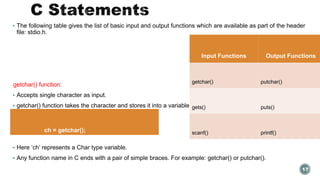
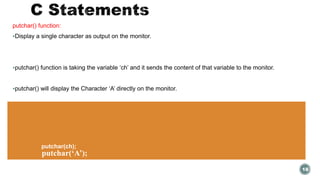
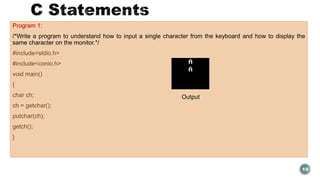
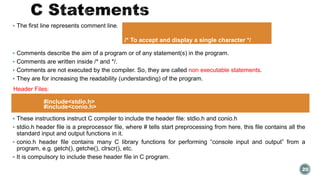
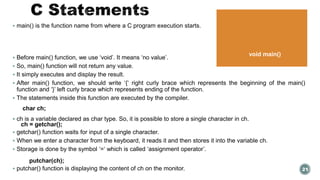
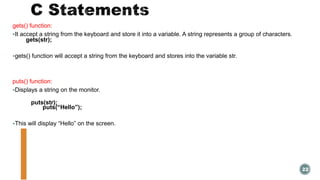
![Program 2:
A program to read and display the name of a person using gets() and puts().
#include<stdio.h>
#include<conio.h>
void main()
{
char str[20];
puts(“Type your Name:”);
gets(str);
puts(str);
getch();
}
23
Output](https://image.slidesharecdn.com/lect-230919084947-cab2cdf5/85/Lect-2-3-Introduction-to-C-ppt-23-320.jpg)
![Observe the program. The first statement in the main() function is: char str[20];
It represents an array (group) of characters. The name of the array is str.
After the array name, we should write [ and ] braces. Here str[] array can have a maximum of 20 characters.
puts(“Type your Name:”);
This will display the message “Type your Name:” to the user.
gets(str);
When the user types the name, it is stored into the array str[] by the gets() function
puts(str);
The puts() function displays the name on the monitor.
24](https://image.slidesharecdn.com/lect-230919084947-cab2cdf5/85/Lect-2-3-Introduction-to-C-ppt-24-320.jpg)

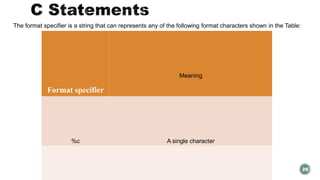
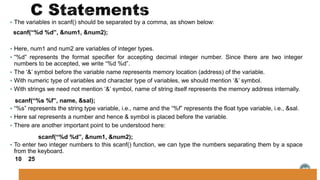
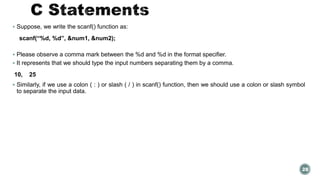
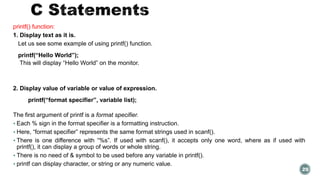
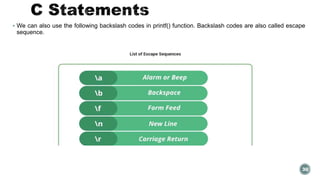
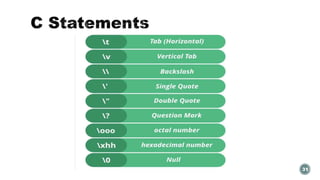
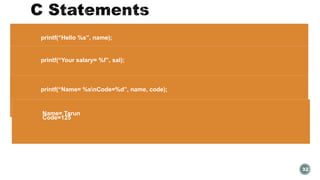
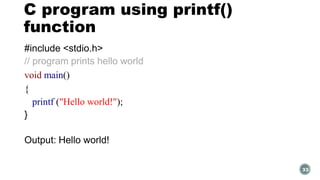

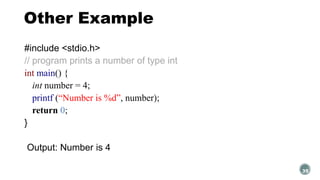
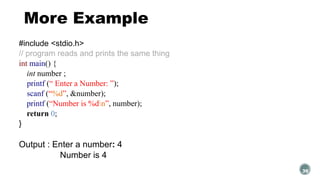
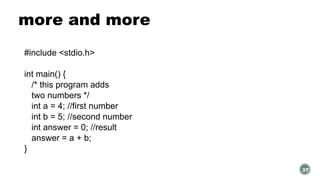
![Program 3:
In this program, we will accept the name of a person and display Birthday wishes to the person.
#include<stdio.h>
#include<conio.h>
void main()
{
char name[20];
printf(“Your good name please:”);
scanf(“%[^n]”, name);
printf(“Hello %s”, name);
printf(“nHappy Birthday to you!”);
getch();
}
38
Output](https://image.slidesharecdn.com/lect-230919084947-cab2cdf5/85/Lect-2-3-Introduction-to-C-ppt-38-320.jpg)
